

 |
 |
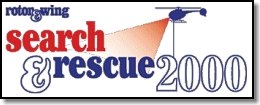 Search and Rescue 2000, sponsored by Rotor & Wing magazine, was held December 5-7, 2000, in Panama City, Florida. This second annual effort was larger than last year's and for the most part was much improved. Inviting the EMS community to participate helped swell the ranks of both attendees and exhibitors.
Search and Rescue 2000, sponsored by Rotor & Wing magazine, was held December 5-7, 2000, in Panama City, Florida. This second annual effort was larger than last year's and for the most part was much improved. Inviting the EMS community to participate helped swell the ranks of both attendees and exhibitors.
Many foreign uniforms and conversation in a variety of languages and accents gave the conference an international flavor. SAR 2000 proved a great opportunity to meet fellow SAR professionals and share lessons learned, as always one of the most valuable benefits of such meetings.
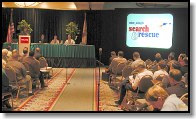 Overall, attendees seemed pleased with the conference. The most notable disappointment, expressed by a number of participants to this reporter (who can confirm the problem), had to do with some of the presentations. Three of these turned out to be little more than sales pitches by company representatives. It was an appalling breach of etiquette. Said one SAR officer in a disgusted tone, "the place for such sales pitches is in the exhibition hall." However, the remaining presentations and presenters did a good job and were well received and appreciated.
Overall, attendees seemed pleased with the conference. The most notable disappointment, expressed by a number of participants to this reporter (who can confirm the problem), had to do with some of the presentations. Three of these turned out to be little more than sales pitches by company representatives. It was an appalling breach of etiquette. Said one SAR officer in a disgusted tone, "the place for such sales pitches is in the exhibition hall." However, the remaining presentations and presenters did a good job and were well received and appreciated.
At the conference dinner on Wednesday evening the winners of the Rotor & Wing Helicopter Heroism Award were presented. The stirring story of this rescue by Los Angeles County Sheriff's Department Air Rescue 5 air crew can be reviewed on the Rotor & Wing Web site (opens new browser window). Dinner attendees were treated to actual video of the rescue and discussion by the crew of their experience. This was one of the high points of the conference for many attendees.
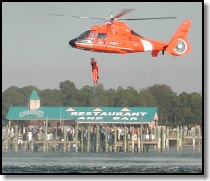 This year's conference included two demonstrations by the U.S. Coast Guard. A small boat and helicopter demo on the bay adjacent to the hotel provided attendees an opportunity to see how the Coast Guard operates. An HH65 Dolphin helicopter out of Air Station New Orleans performed a variety of pickups, both with and without the assistance of the Coast Guard rescue swimmer. The demo concluded with the sodden "survivor" deposited into the well deck of the 41-foot Utility Boat from Coast Guard Station Panama City.
This year's conference included two demonstrations by the U.S. Coast Guard. A small boat and helicopter demo on the bay adjacent to the hotel provided attendees an opportunity to see how the Coast Guard operates. An HH65 Dolphin helicopter out of Air Station New Orleans performed a variety of pickups, both with and without the assistance of the Coast Guard rescue swimmer. The demo concluded with the sodden "survivor" deposited into the well deck of the 41-foot Utility Boat from Coast Guard Station Panama City.
The next day, out at the hotel pool, attendees received a clear demonstration of the superiority of 406 MHz emergency beacons. Lieutenant Commander Paul Steward, who heads up the 406 MHz rescue beacon effort out of USCG HQ, demonstrated a variety of 406 MHz beacons (with the cooperation of the Chelton Group (ACR, NAT, Artex) who provided the beacons and associated electronics for the demo). Included in the pool were five EPIRBs, with and without GPS, as well as a PLB and an ELT on the deck.
A direct link with NOAA allowed for the digital beacon data from all the beacons to be faxed directly to poolside, which was then passed around to those observing. Location data received was within a few feet of the actual pool location for the GPS enabled beacons and not much further for the rest. It was an impressive demonstration of the rapid response and accuracy of 406 beacons compared to traditional 121.5/243 MHz technology that is already nearing the end of its effectiveness.
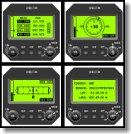 Chelton also demonstrated a prototype of their System 7 DF which allows for sophisticated direction finding off both the normal 121.5/243 MHz homing beacon and, uniquely, off the 406 MHz data stream as well. With selectable displays, it makes it very easy to DF on the signal, and also decodes the digital data as well, potentially useful information. Besides the working prototype set up at the pool, Chelton also had a technology demonstrator functioning on a laptop, allowing attendees to get a hands-on feel for the flexibility of the technology.
Chelton also demonstrated a prototype of their System 7 DF which allows for sophisticated direction finding off both the normal 121.5/243 MHz homing beacon and, uniquely, off the 406 MHz data stream as well. With selectable displays, it makes it very easy to DF on the signal, and also decodes the digital data as well, potentially useful information. Besides the working prototype set up at the pool, Chelton also had a technology demonstrator functioning on a laptop, allowing attendees to get a hands-on feel for the flexibility of the technology.
The system is comprised of a very small DF antenna and a controller for the the receiver functions (Scan, DF, Homing, and 406 MHz decoding) which is contained in the base of the antenna. When in scan mode the unit can scan all of the normal emergency frequencies (121.5, 156.8, 243, and 406.025 MHz). It will also scan and DF an additional four channels (for a total of eight) if required for training or special mission requirements. Chelton claims that state-of-the-art techniques are employed in the design and construction of the antenna unit to "achieve superior gain to allow for increased operational range during DF or homing missions."
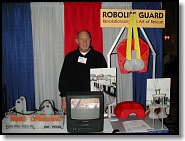 Lutz Wallasch of Euro Precision Tooling was showing off another prototype device that he has invented. This unique, patent pending rescue and grappling device is designed to provide a fail-safe lift or descent by holding onto a person's wrists or forearms. Wallasch's prototypes and video demonstration attracted a good deal of attention from crews who saw numerous possible applications for the concept, from lowering SAR personnel to close quarters hoisting.
Lutz Wallasch of Euro Precision Tooling was showing off another prototype device that he has invented. This unique, patent pending rescue and grappling device is designed to provide a fail-safe lift or descent by holding onto a person's wrists or forearms. Wallasch's prototypes and video demonstration attracted a good deal of attention from crews who saw numerous possible applications for the concept, from lowering SAR personnel to close quarters hoisting.
A pair of padded cammed grippers close down on the wrist or forearm to prevent the hands from slipping through. While obvious having drawbacks in some circumstances, in others it might prove extremely effective and efficient. Single and double arm and both pull and push trigger concepts were displayed. At the moment there are no explicit production plans, Wallasch and his partner were at the conference gauging interest from the SAR community and looking for possible manufacturing and marketing partners.
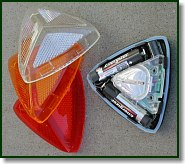 Priority 1 showed off there "Flight Site," portable helicopter landing zone/scene safety kit. These incorporate a set of five of their unique pyramidal low-profile "Lightman" strobe lights. The standard kit includes three colors of lenses (clear, red and orange) which snap onto the strobe body and a variety of mounting systems including a heavy base for landing zone use, all in a small ballistic nylon kit bag. The strobes' lenses are designed to allow them to be viewed from any direction of approach without blinding the pilots. Other color lens are available, including a new infrared (IR) lens for covert or special operations.
Priority 1 showed off there "Flight Site," portable helicopter landing zone/scene safety kit. These incorporate a set of five of their unique pyramidal low-profile "Lightman" strobe lights. The standard kit includes three colors of lenses (clear, red and orange) which snap onto the strobe body and a variety of mounting systems including a heavy base for landing zone use, all in a small ballistic nylon kit bag. The strobes' lenses are designed to allow them to be viewed from any direction of approach without blinding the pilots. Other color lens are available, including a new infrared (IR) lens for covert or special operations.
Flight Site can also be used for traffic control applications with the addition of an optional extension to raise it up off the pavement. Being shown for the first time was a newly developed flag kit that attach to the strobes, further improving visibility. The double AA-battery powered strobes are also available individually and as part of a variety of consumer oriented kits. Additional special purpose mounting brackets are also available.
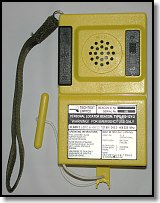 Specmat was showing off its array of communication and emergency beacon devices including their Series 500-12 406 MHz Personal Locator Beacon and 121.5/243 MHz transceiver. This PLB is actually legal to buy in the U.S. because it is also an approved "survival" ELT. At approximately $2500 each for single unit sales, it certainly couldn't be described as "affordable," but it does offer both a moderately small size (5.9 x 3.4 x 1.5 inches, 21.2 oz. / 150 x 87.5 x 37.5 mm, 600 gm) and the added advantage of two-way communications in a U.S. legal package.
Specmat was showing off its array of communication and emergency beacon devices including their Series 500-12 406 MHz Personal Locator Beacon and 121.5/243 MHz transceiver. This PLB is actually legal to buy in the U.S. because it is also an approved "survival" ELT. At approximately $2500 each for single unit sales, it certainly couldn't be described as "affordable," but it does offer both a moderately small size (5.9 x 3.4 x 1.5 inches, 21.2 oz. / 150 x 87.5 x 37.5 mm, 600 gm) and the added advantage of two-way communications in a U.S. legal package.
Ken Burton of STARK Survival was promoting his upcoming SCSI-STARK Open Water Survival Training and Evaluation Program to be held in Panama City, Florida, on May 7 - 9, 2001. Aimed primarily at pilots, flight crew and executive passengers, Ken's open water program is a rare opportunity to get water survival training in a real world environment, including nighttime training on the water which we've found extremely valuable. Another feature is the opportunity to work with a variety of survival products, including new and prototype devices which will be evaluated for effectiveness. Ken has lined up a great group of presenters to supplement his already excellent training curriculum. The program is held in conjunction with the highly respected Southern California Safety Institute (SCSI). (For further information on the program call Marlene Foulk, SCSI: 800-545-3766 or Ken Burton, STARK Survival: 850-871-4730.)
Terry Crownover, Chief Instructor at the Marine Survival Training Center, University of Louisiana at Lafayette, was at SAR 2000 to introduce their programs to the wider SAR community. MSTC specializes in marine survival for the offshore oil industry and, of greater interest to those attending, aviation water survival. Most impressive was the very affordable underwater egress training using the Survival Systems (Canada) METS helicopter ditching simulator. At only $165 per person for the Helicopter Underwater Egress Training course, that's a significant savings over similar training using the METS. MSTC also offers a variety of other aviation related survival training courses, as well as sea survival training from the marine perspective.
|
| SELECT AND USE OUTDOORS AND SURVIVAL EQUIPMENT, SUPPLIES AND TECHNIQUES AT YOUR OWN RISK. Please review the full WARNING & DISCLAIMER about information on this site. |
Publisher and Editor: Doug Ritter
Email: Doug Ritter
URL:
http://www.equipped.org/sar2000.htm
Revision: 02 December 12, 2000
![]()
Email to: [email protected]
|
© 2000 Douglas S. Ritter & Equipped To Survive Foundation, Inc. All rights reserved. Check our Copyright Information page for additional information. |
Read the ETS Privacy Policy |